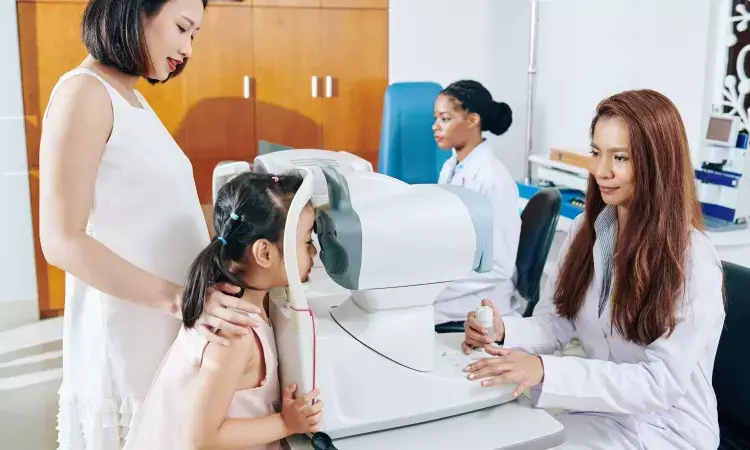- Home
- Medical news & Guidelines
- Anesthesiology
- Cardiology and CTVS
- Critical Care
- Dentistry
- Dermatology
- Diabetes and Endocrinology
- ENT
- Gastroenterology
- Medicine
- Nephrology
- Neurology
- Obstretics-Gynaecology
- Oncology
- Ophthalmology
- Orthopaedics
- Pediatrics-Neonatology
- Psychiatry
- Pulmonology
- Radiology
- Surgery
- Urology
- Laboratory Medicine
- Diet
- Nursing
- Paramedical
- Physiotherapy
- Health news
- Fact Check
- Bone Health Fact Check
- Brain Health Fact Check
- Cancer Related Fact Check
- Child Care Fact Check
- Dental and oral health fact check
- Diabetes and metabolic health fact check
- Diet and Nutrition Fact Check
- Eye and ENT Care Fact Check
- Fitness fact check
- Gut health fact check
- Heart health fact check
- Kidney health fact check
- Medical education fact check
- Men's health fact check
- Respiratory fact check
- Skin and hair care fact check
- Vaccine and Immunization fact check
- Women's health fact check
- AYUSH
- State News
- Andaman and Nicobar Islands
- Andhra Pradesh
- Arunachal Pradesh
- Assam
- Bihar
- Chandigarh
- Chattisgarh
- Dadra and Nagar Haveli
- Daman and Diu
- Delhi
- Goa
- Gujarat
- Haryana
- Himachal Pradesh
- Jammu & Kashmir
- Jharkhand
- Karnataka
- Kerala
- Ladakh
- Lakshadweep
- Madhya Pradesh
- Maharashtra
- Manipur
- Meghalaya
- Mizoram
- Nagaland
- Odisha
- Puducherry
- Punjab
- Rajasthan
- Sikkim
- Tamil Nadu
- Telangana
- Tripura
- Uttar Pradesh
- Uttrakhand
- West Bengal
- Medical Education
- Industry
Visual axis opacification most common complication after primary IOL implementation in pediatric cataract Patients: JAMA

An Original Investigation, "Complications Occurring Through 5 Years Following Primary Intraocular Lens Implantation for Pediatric Cataracts", by Kimberly G. Yen et and team has concluded that the complication following pediatric lensectomy with primary IOL was surgery for VAO. This is associated with primary anterior vitrectomy not being performed but was not associated with age at the surgery or IOL location. The risk of glaucoma development across all ages at surgery suggests a need for long-term monitoring, as highlighted in the study.
The research is published in JAMA Ophthalmology.
To treat nontraumatic pediatric cataracts, a Lensectomy with a primary intraocular lens (IOL) is often used. There needs to be more data evaluating the association of age and IOL location with the incidence of complications, as the present data available is scarce.
The main question is, “Is age at the surgery or location of implant fixation associated with complications within five years of primary intraocular lens implantation for pediatric cataracts?”
In the present study, researchers described the incidence of complications and additional eye surgeries through 5 years following pediatric lensectomy with primary IOL implantation and its association with age at surgery. IOL location in their prospective cohort study using Pediatric Eye Disease Investigator Group cataract registry data from 61 institution- and community-based practices over three years (June 2012 to July 2015).
The main points of this research include:
- The study had 491 children (609 eyes).
- These children were younger than 13 years.
- The common complications were Visual axis opacification (VAO), with a cumulative incidence of 32 %.
- There were no differences in the incidence of surgery for VAO by age at the surgery or by capsular bag vs sulcus IOL fixation.
- There was a lower Cumulative incidence of anterior vitrectomy at the time of IOL placement.
- There was no association between Cumulative incidence of glaucoma-related adverse events by five years and age at surgery, and retinal detachment and endophthalmitis were rare.
Based on the findings of this study, age at implantation and implant location were not associated with complications. There is a need to monitor for glaucoma and VAO.
Further reading:
https://jamanetwork.com/journals/jamaophthalmology/article-abstract/2806303
BDS, MDS in Periodontics and Implantology
Dr. Aditi Yadav is a BDS, MDS in Periodontics and Implantology. She has a clinical experience of 5 years as a laser dental surgeon. She also has a Diploma in clinical research and pharmacovigilance and is a Certified data scientist. She is currently working as a content developer in e-health services. Dr. Yadav has a keen interest in Medical Journalism and is actively involved in Medical Research writing.
Dr Kamal Kant Kohli-MBBS, DTCD- a chest specialist with more than 30 years of practice and a flair for writing clinical articles, Dr Kamal Kant Kohli joined Medical Dialogues as a Chief Editor of Medical News. Besides writing articles, as an editor, he proofreads and verifies all the medical content published on Medical Dialogues including those coming from journals, studies,medical conferences,guidelines etc. Email: drkohli@medicaldialogues.in. Contact no. 011-43720751


